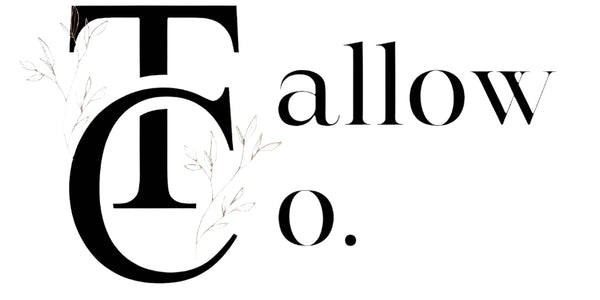
Tallow: An Old-School Remedy for Battling Eczema
Share
If you’ve been dealing with eczema, you know the drill—itchy, inflamed skin that flares up at the worst possible times. You’ve probably tried every cream, lotion, and potion under the sun, from steroid ointments to fancy moisturizers promising relief. But have you ever considered something as simple (and old-fashioned) as tallow? Yep, I’m talking about rendered animal fat—usually from beef or lamb—that’s making a comeback as a natural skincare hero. Stick with me here; it’s not as weird as it sounds, and it might just be the game-changer your skin’s been begging for.
What’s Tallow, Anyway?
Tallow is fat that’s been melted down and purified, traditionally used for everything from cooking to making soap and candles. Think of it as nature’s version of a multi-tasking balm. It’s packed with fatty acids, vitamins, and nutrients that mimic the stuff your skin naturally produces. Unlike synthetic skincare products with a laundry list of unpronounceable ingredients, tallow keeps it real: just pure, grass-fed goodness if you source it right.
For eczema sufferers, the appeal lies in its simplicity and compatibility with human skin. Your skin’s outer layer—called the lipid barrier—is made up of fats like cholesterol, ceramides, and fatty acids. When that barrier gets wrecked (hello, eczema), your skin dries out, cracks, and lets irritants sneak in. Tallow steps in like a reinforcement team, delivering a dose of lipids that can help patch things up.
Why Tallow Might Help Eczema
So, what’s the deal with tallow and eczema? Let’s break it down:
1. Deep Moisturization: Without the JunkEczema skin is notoriously dry, and most commercial moisturizers either sit on top without sinking in or contain fragrances and preservatives that make things worse. Tallow, on the other hand, is occlusive—meaning it seals in moisture—and its fatty acid profile (like stearic and oleic acids) mimics your skin’s natural oils. It’s like giving your skin a drink it can actually use, not just a splash of water that evaporates in ten minutes.
2. Nutrient Boost: Grass-fed tallow isn’t just fat—it’s loaded with fat-soluble vitamins like A, D, E, and K. Vitamin E, for instance, is a powerhouse antioxidant that can calm inflammation, while vitamin A supports skin repair. Eczema-prone skin often needs all the help it can get to heal, and tallow delivers these goodies in a way that synthetic vitamins in lotions can’t always match.
3. Anti-Inflammatory Vibes: The omega-3s and conjugated linoleic acid (CLA) in grass-fed tallow might help dial down inflammation—a big driver of eczema flare-ups. While it’s not going to replace your doctor-prescribed anti-inflammatory treatments, it could be a gentle, natural sidekick to keep things under control.
4. No Irritating Additives: One of the sneakiest eczema triggers? The artificial stuff in skincare products—think parabens, sulfates, or synthetic scents. Tallow skips all that. If you get pure, high-quality tallow (or a balm made with minimal extras like beeswax), you’re dodging the irritants that might be secretly sabotaging your skin.
How to Use Tallow for Eczema
Ready to give it a shot? Here’s the lowdown on how to make tallow your skin’s new best friend:
• Source Smart: Go for grass-fed tallow if you can. It’s got a better nutrient profile than grain-fed, and it’s less likely to carry weird residues. You can buy it pre-made from small-batch producers or render it yourself if you’re feeling DIY.
• Test First: Eczema skin is sensitive, so dab a little tallow on a small patch (like your inner arm) and wait 24 hours to make sure you don’t react. Most people tolerate it well, but everyone’s different.
• Apply Sparingly: A little goes a long way. Warm a pea-sized amount between your fingers until it melts, then massage it into damp skin after a shower to lock in hydration.
• Pair It Up: Some folks mix tallow with a drop of essential oil (like lavender, if your skin can handle it) or use it alongside their usual eczema routine. Just don’t overdo it—let your skin tell you what it likes.
Does It Actually Work?
Here’s where it gets real: there’s no mountain of clinical studies proving tallow cures eczema. Most of the buzz comes from anecdotal evidence—people swearing by it on forums, blogs, and social media. Some say it’s softened their rough patches and cut down on itching within days; others notice it takes weeks to see a difference. The science behind its fatty acids and vitamins checks out, though—it’s not a stretch to see why it could help.
That said, eczema’s a tricky beast. What works for one person might not for another, and tallow isn’t a magic bullet. If your flares are severe or infected, it’s not a substitute for medical treatment. Think of it more as a supportive player, not the whole game plan.
The Bottom Line
Tallow might sound like a throwback (because it is), but that’s part of its charm. It’s a no-frills, back-to-basics option for anyone tired of overpriced creams that don’t deliver. If your eczema’s got you desperate for relief, it’s worth a try—especially if you’re into natural remedies that don’t mess around with your skin’s chemistry. Just keep your expectations realistic, source it well, and listen to your skin.
Have you tried tallow for eczema—or got another go-to remedy? Drop your thoughts below. I’d love to hear what’s working for you!
